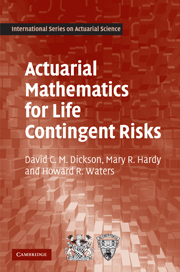Book contents
- Frontmatter
- Contents
- Preface
- 1 Introduction to life insurance
- 2 Survival models
- 3 Life tables and selection
- 4 Insurance benefits
- 5 Annuities
- 6 Premium calculation
- 7 Policy values
- 8 Multiple state models
- 9 Pension mathematics
- 10 Interest rate risk
- 11 Emerging costs for traditional life insurance
- 12 Emerging costs for equity-linked insurance
- 13 Option pricing
- 14 Embedded options
- A Probability theory
- B Numerical techniques
- C Simulation
- References
- Author index
- Index
8 - Multiple state models
- Frontmatter
- Contents
- Preface
- 1 Introduction to life insurance
- 2 Survival models
- 3 Life tables and selection
- 4 Insurance benefits
- 5 Annuities
- 6 Premium calculation
- 7 Policy values
- 8 Multiple state models
- 9 Pension mathematics
- 10 Interest rate risk
- 11 Emerging costs for traditional life insurance
- 12 Emerging costs for equity-linked insurance
- 13 Option pricing
- 14 Embedded options
- A Probability theory
- B Numerical techniques
- C Simulation
- References
- Author index
- Index
Summary
Summary
In this chapter we reformulate the survival model introduced in Chapter 2 as an example of a multiple state model. We then introduce several other multiple state models which are useful as models for different types of life insurance policies. A general definition of a multiple state model, together with assumptions and notation, is given in Section 8.3. In Section 8.4 we discuss the derivation of formulae for probabilities and in Section 8.5 the numerical evaluation of these probabilities. This is extended in Section 8.6 to premium calculation and in Section 8.7 to the numerical evaluation of policy values.
In the final three sections we study in more detail some specific multiple state models that are particularly useful – a multiple decrement model, the joint life and last survivor model and a model where transitions can take place at specified ages.
Examples of multiple state models
Multiple state models are one of the most exciting developments in actuarial science in recent years. They are a natural tool for many important areas of practical interest to actuaries. They also simplify and provide a sound foundation for some traditional actuarial techniques. In this section we illustrate some of the uses of multiple state models using a number of examples which are common in actuarial practice.
- Type
- Chapter
- Information
- Actuarial Mathematics for Life Contingent Risks , pp. 230 - 289Publisher: Cambridge University PressPrint publication year: 2009

